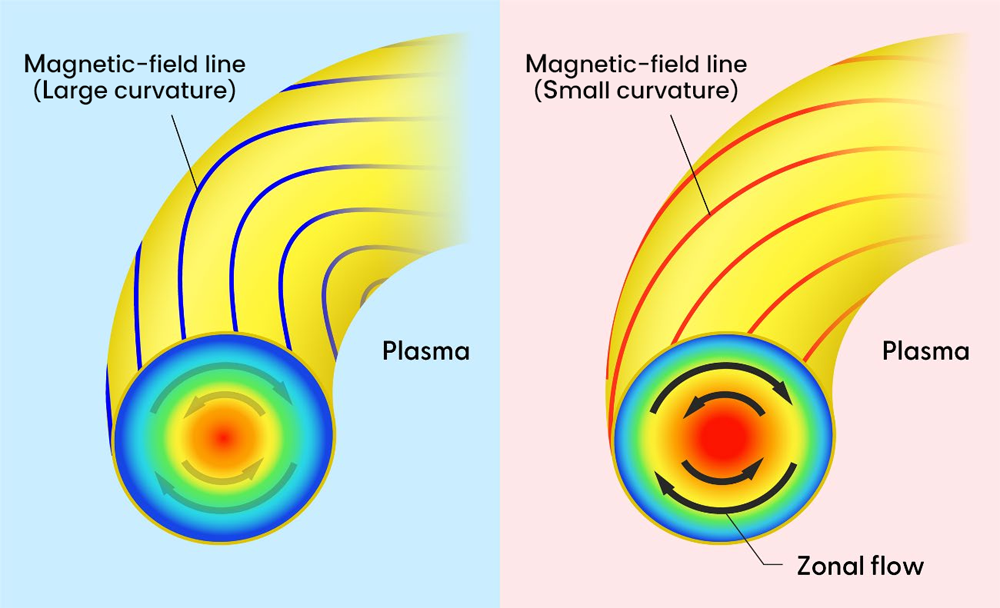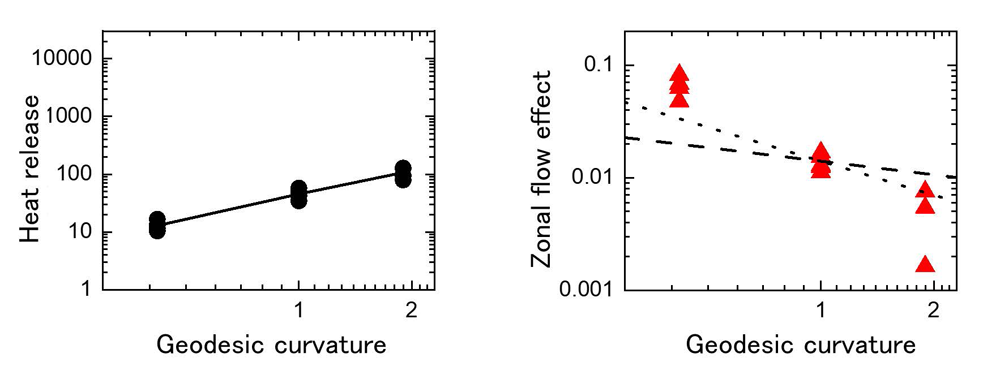Successful control of turbulent transport
To extract fusion energy, plasma exceeding 100 million degrees Celsius is required. Research is being conducted worldwide to increase the temperature of plasma confined by magnetic fields. However, it has been discovered that fluctuations in plasma density and temperature cause a phenomenon that releases heat from the plasma, leading to a decrease in its temperature. By carefully designing the shape of the magnetic field that confines the plasma, researchers have successfully suppressed the heat release phenomenon caused by these fluctuations.


In magnetic confinement fusion research, where high-temperature plasma is confined using magnetic fields, studies on magnetic-field configurations that can efficiently contain the plasma have been ongoing since the early days of fusion energy research. Significant progress has been made in understanding the orbits of charged particles and suppressing fluctuations. Among these findings, it has been discovered that the formation of zonal flows—banded flows within the plasma—can suppress the heat release caused by fluctuations. Since these are nonlinear phenomena, accurately predicting them is extremely difficult. However, detailed research has advanced through calculations using supercomputers. Developing methods to achieve higher plasma temperatures by utilizing the effects of these zonal flows *1 has been an urgent challenge. Recent studies based on theoretical calculations have shown that by carefully designing the shape of the magnetic field (specifically by reducing the geodesic curvature *2 of magnetic-field lines), the effects of zonal flows can be enhanced. We have embarked on experimental research to validate this theoretical study.
This research required several conditions: the ability to flexibly control the shape of the magnetic field that confines the plasma, the capability to measure plasma fluctuations, and the establishment of a method to quantitatively evaluate heat release. The Large Helical Device (LHD) was identified as the optimal apparatus to meet these conditions, and experiments were conducted to significantly alter the geodesic curvature of the magnetic field.
Using two different analytical methods, we investigated the relationship between heat release, the magnitude of fluctuations, and the geodesic curvature of the magnetic field. The first method was based on statistical and mathematical techniques, while the second was based on a simplified model of heat release caused by fluctuations. Since both independent analyses aligned with the theoretical research, we were able to experimentally validate the theory.
This study is highly significant as it has demonstrated that the heat release caused by fluctuations can be controlled by the shape of the magnetic field. While research on the zonal-flow effect has traditionally focused on understanding this nonlinear phenomenon, our study has advanced the field by shifting the focus toward its control. Moving forward, this research is expected to lead to the development of devices that minimize heat release even when fluctuations occur.
This research was a collaborative effort involving Shu Nishimoto, who was a graduate student at the Graduate School of Science at Nagoya University at the time, along with Kenichi Nagaoka and Motoki Nakata from the National Institute for Fusion Science. It was published on February 29, 2024 in Plasma Physics and Controlled Fusion, an international journal on plasma physics.
Publication
- S. Nishimoto et al., "Experimental study of the effect of geodesic curvature on turbulent transport in magnetically confined plasma", Plasma Physics and Controlled Fusion 66 (2024) 045010. [NIFS Repository]
Glossary
*1 Zonal Flow: A striped flow structure driven by fluctuations. The striped patterns seen in Jupiter's atmosphere are also a type of zonal flow.
*2 Geodesic Curvature: An indicator that represents the degree of bending of magnetic field lines.
